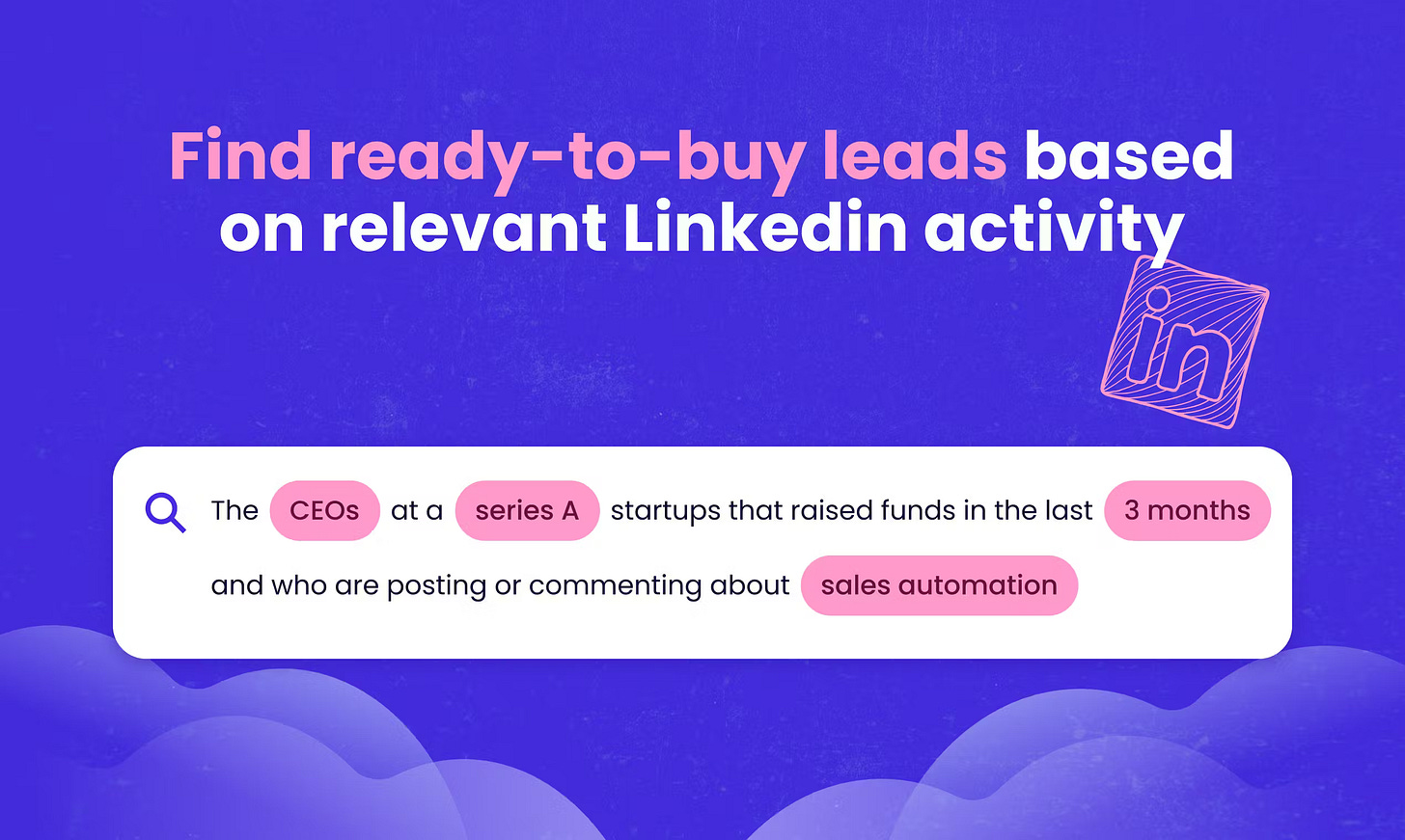Want to attract world-class employees who have so many options? Here's how.
Guest post by Billy Gallagher on how building in public attracts the right people to your startup
⚡️ A QUICK NOTE ABOUT OUR FEATURED SPONSOR ⚡️
Thanks to this edition’s featured sponsor: Intently
Meet Intently — a YC-backed startup that helps turn LinkedIn actions into sales opportunities. The app helps get rid of the manual process of checking leads’ profiles on LinkedIn.
The company is founded by serial entrepreneurs Dmitry Starodubtsev, Slava Solonitsyn, Mika Melchanka, and Sergey Drozdkov who personally experienced challenges related to setting up the sales process and scaling in a fast-growing startup.
The Intently app streamlines lead generation on LinkedIn, catering to solo founders and sales professionals without dedicated marketing or business development teams by automating the identification of warm leads based on relevant intent.
Using AI technology, Intently transforms users' behavioral data on LinkedIn into a feed of ready-to-buy prospects, akin to having your own Google for LinkedIn.
Since its inception, Intently has gained a global user base of 300+ companies.
Today’s essay:
Should more startups build in public to attract employees?
Ask most founders what their worst nightmare is and having their board deck or internal metrics dashboard leaked publicly is pretty high up there.
Should it be? Founders who build in public, typically by sharing metrics, wins, and losses on social media and on their websites, don’t think so.
While the two obvious benefits are attracting VCs and customers, there’s another, less-talked-about benefit of building in public—attracting great talent.

Why building in public might help you recruit great talent
Startups have become one of the best ways for smart, ambitious people to create wealth. That is all contingent, of course, on whether people join the right startup—which means employees in the startup space need to act more like investors. They need to seriously scrutinize the companies they join.
In other words, smart employees join startups because they believe the company—and their equity—will be worth far more in the future.
So what does building in public have to do with any of this?
There’s more noise than ever before for job seekers trying to find the next big thing.
Many of the signals job seekers previously relied on–we raised from this top investor, we’re a unicorn–are no longer trusted after the bubble burst.
Founders are trying to build a following and sense of inevitability–among candidates, VCs, and customers alike–and sharing strong metrics are proof they’re on the right path. If founders aren’t willing to share numbers proving their traction, they have to invest much more time and resources into slowly building that following and sense of inevitability.
While founders think about the downsides of sharing real traction metrics, they often overlook the costs that come from trying to build a movement without sharing enough details.
Sharing metrics both increases your odds of getting strong press coverage and your odds of getting traction if you choose to tell your story directly to your audience.
I think the person that does this the best right now is Eric Glyman at Ramp (examples here and here). Founders with hundreds of millions in revenue have shared metrics, as have ones earlier in their journey and bootstrapped founders. If I were on the job market, I’d be far more likely to join a company whose founder was consistently sharing public metrics than one who wasn’t.
Of course, it’s easy to share metrics when things are going well. Many founders I speak with are overly focused on mitigating downside scenarios where growth stalls and the metrics don’t look great any more. This fear is healthy–startups are about growth and additional pressure to hit key metrics and grow is not necessarily a bad thing.
Founders can also selectively choose which metrics, whether to round some numbers or share percentages, to obfuscate things for a potential competitor while still sharing something useful for potential employees.
This is particularly true for the companies that don’t have brand name backers or pedigreed backgrounds. Ultimately, those things are just an indicator that you may be able to achieve product market fit; founders that have the metrics to prove they have PMF, should show them!
The above post is the first of it’s kind “guest post” on this newsletter. This article is written by Billy Gallagher, the founder and CEO of Prospect, a startup that uses the same data top VCs rely on to give you an independent projection of what your startup equity is likely worth. Before founding Prospect, he was a writer for TechCrunch, a VC at Khosla Ventures, and employee 34 at Rippling.
Note: If you’re interested in surfacing one of your best articles as a guest author to my audience, please reply or hit me up on X at @thisiskp_.
Shoutouts and Sponsors
#1. Recast Studio
Recast is a generative AI tool that automatically turns your podcast episode into short video clips & writes show notes, blog posts, social media posts and more in minutes. I’ve been using it and loving how magical it is! Check it out here.
#2. How to Kill a Startup: A Short, Ten Step Guide
My friend Tom White recently wrote a brief but candid post-mortem on his startup Glyph (founded in 2014). Check it out here.
#3. Build In Public Fellowship (BIPF)
Did you know? BIPF4 is around the corner! We are inviting CEOs and founders of 6-7 figure companies to join us this time. The pitch is simple: “build a high-trust personal brand in 6 weeks.” Cohort 4th (the last one for this year) kicks off on Oct 30. Interested? Apply ASAP here.
How can I help you?
No pressure but whenever you’re ready, here are 2 ways I can help you:
Schedule a quick 1:1 mentorship call with me to get specific tactical and personalized guidance on your product’s go-to-market strategy, Product Hunt launch planning and how to fall in love with build in public.
If you have a business you want to promote to my ~7,000 email and ~43,800 Twitter audience feel free to reply to this email or DM me on Twitter.
And that’s a wrap for now! 🌯
Thank you for giving your attention and checking this edition out 🙏
Did you like this post? It would MEAN A LOT if you can share this on your socials and tag me at @thisiskp_. Thanks again!




🚀🚀🚀🚀